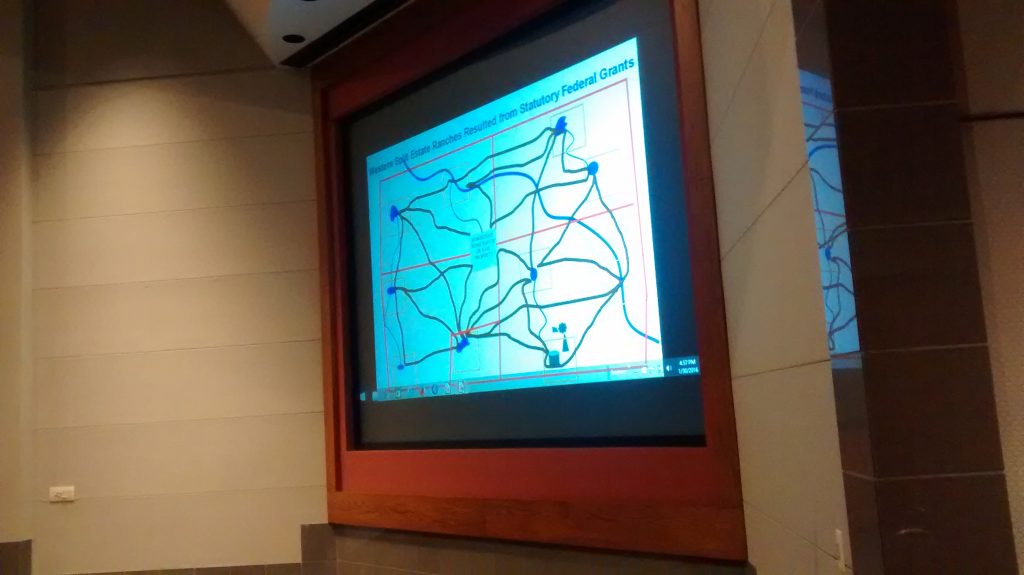Lava Lake Land & Livestock – Finance — By Todd Macfarlane
Lava Lake – Finance, a Combination of Vision, Timing, and Allocation
Investment Icon Warren Buffet has long said (and Allan Nation has quoted) that “The key to wealth is allocation of capital.” As an investment banker, Brian Bean seems to have a solid grasp of this principle. Consequently, at a time when aging sheep ranchers were retiring and leaving the industry in ever increasing numbers, and younger generation ranchers were often switching to cattle, Brian and Kathleen Bean became Idaho sheep ranchers.
At first blush, Beans may seem like unlikely candidates. They work primarily in the San Francisco Bay area, where they live most of the year. Brian is a successful investment banker, who believes we live in a “Pollanesque” world, agriculturally, and is specifically interested in helping to finance sustainable agriculture projects. The couple also has a specific interest in environmental conservation and activism, as evidenced by Kathleen’s work as development director for the Nature Conservancy. They have two teen-age daughters, who seem to be embracing the same interests and ideals.
Back in the late nineties, with ample financial resources in hand from other investments and business ventures, Beans began looking for a ranch in the Mountain West. Although they started out looking in Wyoming, their search soon led them to Idaho. While most other similarly situated buyers typically choose to buy “trophy” ranches in places like the affluent Wood River Valley, in and around Ketchum, Beans ultimately decided to take a more production-oriented approach.
Their first acquisition, in 1999, was the Lava Lake Ranch, an old sheep outfit that had been converted to cattle, comprising approximately 7000 acres of private land, which Beans put under a conservation easement as part of the deal. The ranch is headquartered in Blaine County, at the base of the Pioneer Mountains, just outside the small town of Carey, Idaho, and adjacent to Craters of the Moon National Monument. As the crow flies, ranch headquarters is less than an hour from the Wood River Valley, Ketchum, and the Sun Valley resort area. And parts of the high country sheep summer range look right down on those areas.
Like many affluent modern ranch real estate investors, Beans didn’t necessarily start out with major production aspirations. Their initial approach was almost entirely from an environmental preservation perspective, with the intent of fully utilizing conservation easements to protect the land from development, and benefit native wildlife, etc. Unlike many other environmental activists, however, Beans experienced a major paradigm shift. Among other things, they realized that their environmental goals and objectives were not incompatible with continued production and other beneficial uses of the land. They also realized that not only could sheep be used as an effective conservation and range management tool, but that they could also develop a very sustainable and financially viable business model in the sheep business. As part of their evolving paradigm, they developed a whole new vision for an unusual, multi-generational and multi-dimensional, environmentally-friendly sheep ranching operation. In light of all the aging and retiring ranchers in the area, their timing probably couldn’t have been better.
Taking a broad landscape view, Beans eventually developed a vision for a unique nexus of opportunities for land and resource ownership and management, environmental stewardship and conservation, and sustainable, profitable agricultural production. Based on that unique vision, over the course of the next few years, they acquired and assembled five additional existing ranching operations, totaling approximately 24,000 acres of private land. Of their total private land holdings, however, less than 500 acres is expensive irrigated cropland and/or irrigated pasture. The vast majority of their private property is essentially unimproved native rangeland in and around the foothills of the Pioneer Mountains. The vast majority of the land they utilize for grazing, comprising several hundreds of thousands of additional acres from the desert to the mountains, however, is public land in grazing allotments administered by the United States Forest Service and Bureau of Land Management.
Right at a time and in an area where there was so much environmental pressure to completely eliminate livestock grazing on public lands, and many long-time ranchers were becoming very concerned about the future of public lands grazing, Beans realized that by continuing to utilize the public lands livestock grazing permits that went with their private base property, they could become major stakeholders and could have much more say in the management of the adjoining public lands. They also realized that if they were to choose not to graze the public lands, they would lose the ability to be actively involved in hands-on management of those lands.
Once Beans made those realizations, and accompanying commitments, they jumped into sheep ranching with both feet. They also embraced and began advocating the position that continued production and multiple, beneficial uses of public lands were not necessarily incompatible with sound stewardship. Today, they run about 5600 head of ewes, and intend to ultimately expand that number to around 6800, which they consider to be about the optimal scale and number for their operation.
Although there were upfront costs involved in acquiring the public land grazing permits, acquisition costs for those permits were much less than private property, and the ongoing annual per AUM grazing fees are quite reasonable. But they do require intensive management, including constant herding by hired shepherds as described in the production installment.
Although Beans are very actively involved in the vision and operation of the entire spectrum of the Lava Lake sheep operation, from production to marketing, because it has been their desire to develop a sustainable, multi-generational family business model, and because they are busy with other productive occupational ventures as well, in addition to hired shepherds, they also rely on hired on-the-ground management.
Based largely on their unique environmental conservation priorities, when hiring a general manager, instead of choosing an experienced sheep operator, they hired Mike Stevens, a very experienced, talented and well-thought-of, land, resource and project manager, who was then managing the nearby Silver Creek Preserve for the Nature Conservancy. Despite his own environmental conservation background and the necessity of learning the sheep business completely from scratch, however, Mike Stevens has played a very instrumental role in developing and implementing the vision for the sheep operation. While Stevens is the overall ranch operation manager, when Beans bought out Pete Cenerussa’s sheep outfit, they hired his experienced sheep manager, Pedro Loyola, to be the sheep foreman for their whole operation.
Otherwise, Lava Lake seeks to distinguish itself in a variety of ways. When it comes to financial aspects of the operation, one of the first is a “minimalist” approach, and conspicuous absence of expensive improvements and infrastructure. There is, for example, no elaborate “owner’s home” on any of the ranch properties. From Spring to Fall, Lava Lake’s sheepherders all live in antique portable sheep camp wagons with canvas covered tops that resemble prairie schooners. In stark contrast to many of the “trophy ranches” in the nearby Wood River Valley and Sun Valley, Lava Lake runs a very lean production operation.
Lava Lake’s general philosophy and approach, including everything from minimal infrastructure and environmental conservation to direct marketing, seem to be generally well received in Blaine County and elsewhere, and particularly in the affluent Wood River Valley. In the more traditional, conservative and production-oriented town of Carey, which is the community closest to the ranch’s operational headquarters, and where change is viewed with more skepticism, however, despite Lava Lake’s lean, unostentatious approach, it is probably fair to say that the perception and reception are more reserved.



